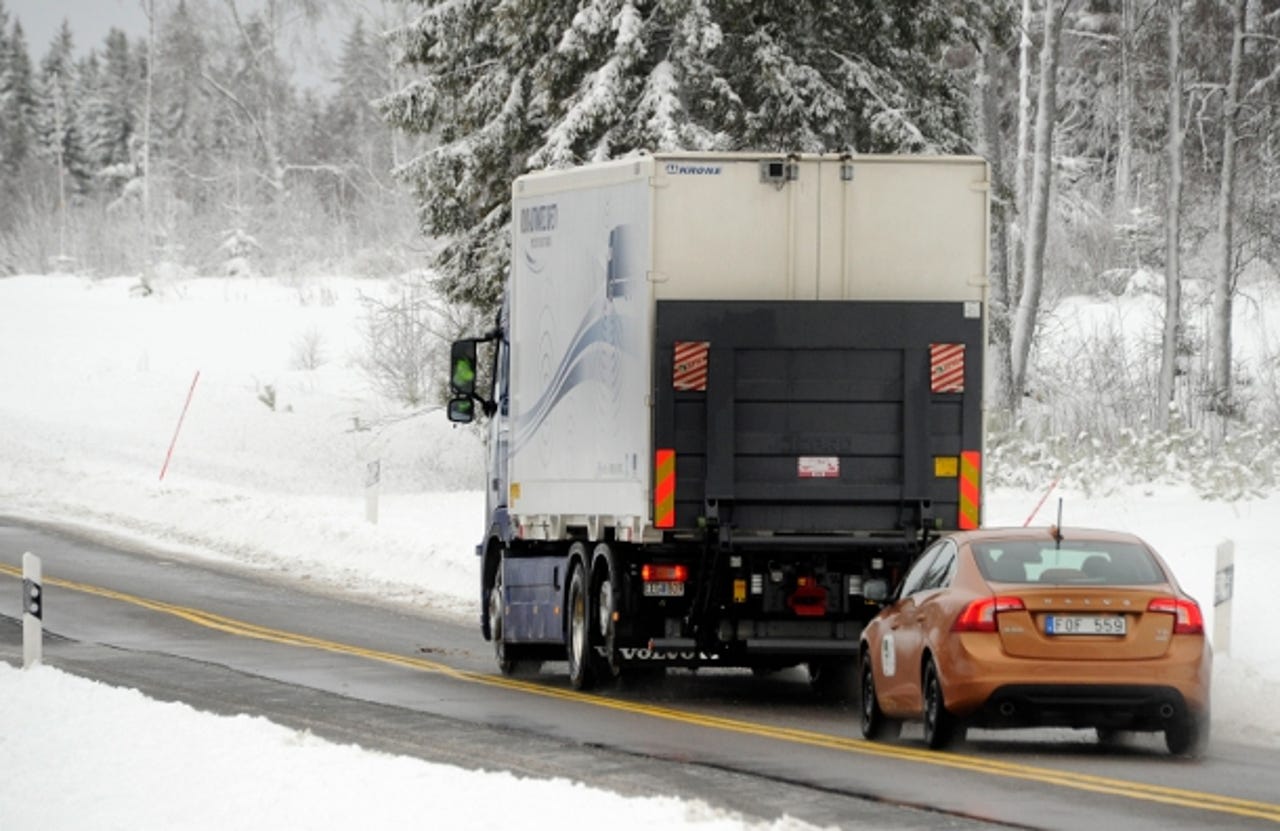Photos: Robotic car convoy gets motoring


European Commission-funded Sartre project aims to reduce accidents, congestions and emissions
It may seem like something out of Bladerunner but a European Commission-funded research project could result in automated road trains - or platoons - travelling on Europe's motorways by 2021.
Given the go-ahead in 2009, Safe Road Trains for the Environment, or Sartre, is a three-year project to develop a system to enable cars to follow and be controlled by a lead vehicle. One of the conditions of the project is that the system won't require any changes to be made to the roads used by the platoons.
Shown above is the first test of the technology outside a simulator, which was carried out at Volvo's Hällered test track near Gothenburg in Sweden in December. The Volvo S60 is being directed and controlled by the truck, which is being driven by a professional driver.
The project is being led by Leamington Spa-based product development company Ricardo UK in collaboration with Spain's Idiada and Robotiker-Tecnalia, Germany's Institut für Kraftfahrwesen in Aachen and Sweden's SP Technical Research Institute as well as Volvo Car Corporation and Volvo Technology.
Volvo became involved due to the potential of its existing lane assistance and adaptive cruise control car production technology - which monitors and controls the distance between cars - to form the basis of the automated convoy.
The idea is that once their car has joined a convoy, drivers can get on with other tasks such as work or simply put their feet up and read the paper as shown above.
As well as the comfort benefits for drivers, the project aims to achieve significant environmental and safety benefits.
Due to more efficient braking and acceleration, the project estimates up to 20 per cent fuel savings, which would also reduce CO2 emissions.
Volvo technical leader for active safety functions Dr Erik Coelingh told silicon.com the vast majority of accidents are caused by human error. The European Commission estimates that human factors cause at least 80 per cent of road traffic accidents, so automating some of the driving functions should cut down accident rates.
The automated road trains could also relieve traffic congestion due to the smaller gap between vehicles and consistent speed of platoons.
Volvo's lane assistance and adaptive cruise control systems have been combined with cameras and radar fitted to the vehicles using a wireless network.
Due to the specific demands of the system, the existing Volvo technology needs to be tweaked, according to Coelingh.
As the convoy requires the distance between vehicles to be much shorter than the standard adaptive cruise control system will allow, the parameters need to be altered. And, due to the greater proximity of the vehicles, the lane assistance system is unable to see lane markings so is redirected to focus on the lateral movement of the vehicle in front to ensure the vehicles stay in line.
Coelingh said one of the main challenges in adapting this technology is minimising error rates so following vehicles don't move too far out of line if these errors are replicated.
Shown above is a diagram of what happens when a car wants to join the convoy. The driver of the brown car approaches the back of the convoy and the car communicates with the platoon network to request permission to join.
Once it has permission, the driver can approach the back of the convoy and the system takes control of the car.
The vehicles are fitted with transponders that create a 5.9GHz network transmitting data to and from the other vehicles in the convoy using the IEEE 802.11p standard, developed specifically for intelligent transport systems.
The project is looking at developing a parallel system - likely to use 3G - which can act as a back-up if the main network fails.
Ricardo UK is developing the controller element of the network, which requires complex algorithms that take into account all the factors needed for the system to control the platoon.
When drivers need to leave the convoy - to exit the motorway at a junction, for example - they elect to leave the network and resume control of their vehicles. If a gap is left between vehicles, the car behind accelerates to close the gap with the car in front.
The symbols by each car indicate what activities drivers can pursue once they no longer need to focus on driving.
Volvo's Coelingh said more tests will take place in 2011 with more vehicles being added to the road train during the summer.
He added that as well as the technology challenges, the public perception of automated platoons will need to be tackled if the system is to take off. Part of this process will involve working out what information drivers want to see - such as a camera view of the road in front of the lead vehicle - when travelling in an automated convoy.
Although it's early days for the development of the technology, Volvo's Coelingh said he can imagine this type of automated convoy being seen on the road in 10 years.